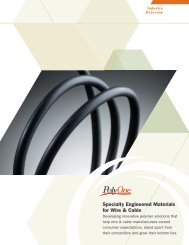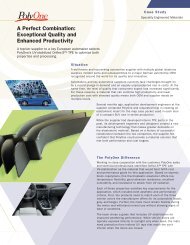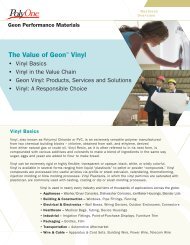PolyOne 2009 Annual Report
PolyOne 2009 Annual Report
PolyOne 2009 Annual Report
Create successful ePaper yourself
Turn your PDF publications into a flip-book with our unique Google optimized e-Paper software.
POLYONE CORPORATION<br />
our backlog is a meaningful indicator of the level of our present or<br />
future business.<br />
Working Capital Practices<br />
Our products are generally manufactured with a short turnaround<br />
time, and the scheduling of manufacturing activities from customer<br />
orders generally includes enough lead time to assure delivery of an<br />
adequate supply of raw materials. We offer payment terms to our<br />
customers that are competitive. We generally allow our customers<br />
to return merchandise if pre-agreed quality standards or specifications<br />
are not met; however, we employ quality assurance practices<br />
that seek to minimize customer returns. Our customer returns are<br />
immaterial.<br />
Significant Customers<br />
No customer accounts for more than 3% of our consolidated revenues,<br />
and neither we nor any of our operating segments would<br />
suffer a material adverse effect if we were to lose any single<br />
customer.<br />
Research and Development<br />
We have substantial technology and development capabilities. Our<br />
efforts are largely devoted to developing new product formulations<br />
to satisfy defined market needs, providing quality technical services<br />
to evaluate alternative raw materials, assuring the continued success<br />
of our products for customer applications, providing technology<br />
to improve our products, processes and applications, and<br />
providing support to our manufacturing plants for cost reduction,<br />
productivity and quality improvement programs. We operate<br />
research and development centers that support our commercial<br />
development activities and manufacturing operations. These facilities<br />
are equipped with state-of-the-art analytical, synthesis, polymer<br />
characterization and testing equipment, along with pilot plants<br />
and polymer compounding operations that simulate specific production<br />
processes that allow us to rapidly translate new technologies<br />
into new products.<br />
Our investment in product research and development was<br />
$22.9 million in <strong>2009</strong>, $26.5 million in 2008 and $21.6 million<br />
in 2007. In 2010, we expect our investment in research and<br />
development to increase moderately as we deploy greater<br />
resources to focus on material and service innovations.<br />
Methods of Distribution<br />
We sell products primarily through direct sales personnel, distributors,<br />
including our <strong>PolyOne</strong> Distribution segment, and commissioned<br />
sales agents. We primarily use truck carriers to transport our<br />
products to customers, although some customers pick up product<br />
at our operating facilities or warehouses. We also ship some of our<br />
manufactured products to customers by railroad cars.<br />
Employees<br />
As of February 1, 2010, we employed approximately 3,900 people.<br />
Less than 2% of our employees are represented by labor unions<br />
under collective bargaining agreements. We believe that relations<br />
with our employees are good, and we do not anticipate significant<br />
operating issues to occur as a result of current negotiations or when<br />
we renegotiate collective bargaining agreements as they expire.<br />
Environmental, Health and Safety<br />
We are subject to various environmental laws and regulations that<br />
apply to the production, use and sale of chemicals, emissions into<br />
the air, discharges into waterways and other releases of materials<br />
into the environment and the generation, handling, storage, transportation,<br />
treatment and disposal of waste material. We endeavor<br />
to ensure the safe and lawful operation of our facilities in the<br />
manufacture and distribution of products, and we believe we are<br />
in material compliance with all applicable laws and regulations.<br />
We maintain a disciplined environmental and occupational<br />
safety and health compliance program and conduct periodic internal<br />
and external regulatory audits at our facilities to identify and categorize<br />
potential environmental exposures, including compliance<br />
matters and any actions that may be required to address them. This<br />
effort can result in process or operational modifications, the installation<br />
of pollution control devices or cleaning up grounds or facilities.<br />
We believe that we are in material compliance with all<br />
applicable requirements.<br />
We are strongly committed to safety as evidenced by our injury<br />
incidence rate of 0.9 per 100 full-time workers per year in <strong>2009</strong>, an<br />
improvement from 1.1 in 2008. The 2008 average injury incidence<br />
rate for our NAICS Code (326 Plastics and Rubber Products Manufacturing)<br />
was 5.7.<br />
In our operations, we must comply with product-related governmental<br />
law and regulations affecting the plastics industry generally<br />
and also with content-specific law, regulations and nongovernmental<br />
standards. We believe that compliance with current<br />
governmental laws and regulations and with non-governmental content-specific<br />
standards will not have a material adverse effect on<br />
our financial position, results of operations or cash flows. The risk<br />
of additional costs and liabilities, however, is inherent in certain<br />
plant operations and certain products produced at these plants, as<br />
is the case with other companies in the plastics industry. Therefore,<br />
we may incur additional costs or liabilities in the future. Other<br />
developments, such as increasingly strict environmental, safety<br />
and health laws, regulations and related enforcement policies,<br />
including those under the Restrictions on the Use of Certain Hazardous<br />
Substances (RoHS) and the Consumer Product Safety Information<br />
Act of 2008, the implementation of additional contentspecific<br />
standards, discovery of unknown conditions, and claims<br />
for damages to property, persons or natural resources resulting<br />
from plant emissions or products could also result in additional<br />
costs or liabilities.<br />
6



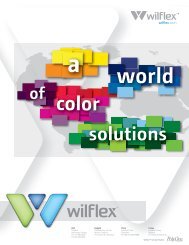
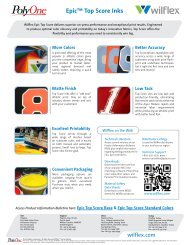
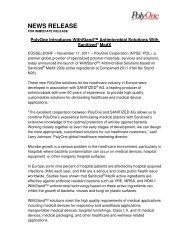

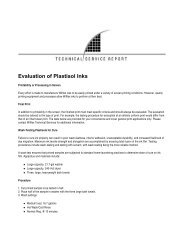
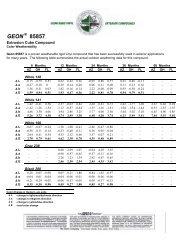
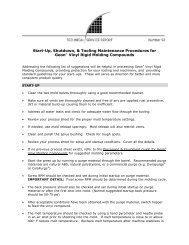
![TPE Injection Molding Guide [PDF] - GLS Thermoplastic Elastomers](https://img.yumpu.com/26329362/1/190x245/tpe-injection-molding-guide-pdf-gls-thermoplastic-elastomers.jpg?quality=85)

